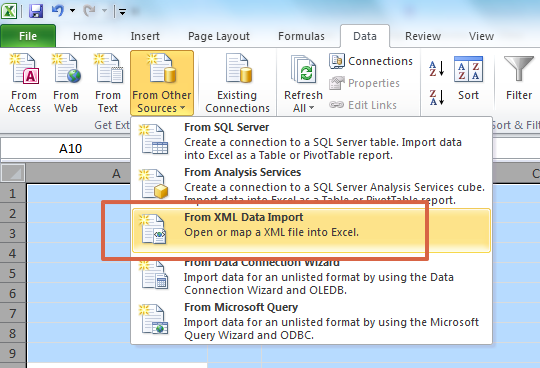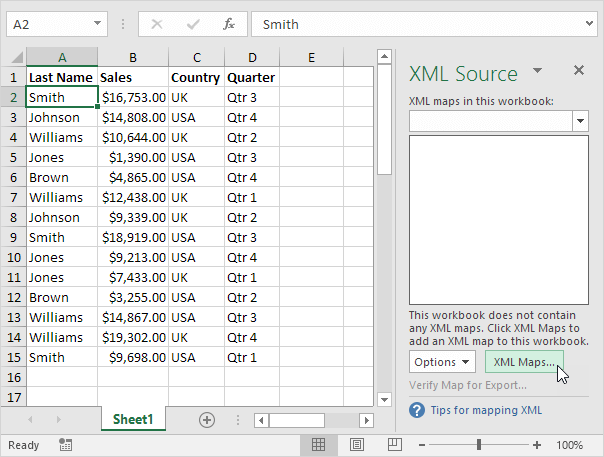

The schema definition of a mapped element is contained within a sequence with the following attributes: This relationship may not be preserved for the following reasons: Although the child element (if Excel supports it) can be displayed, the text content will be lost when the data is imported, isn't available when the data is exported, and therefore can't be round-tripped.Īn XML Map can't be exported if the mapped element’s relationship with other elements can't be preserved. One common case is where formatting tags (such as the bold tags) are used to mark up data within an element. Mixed content occurs when an element has a child element and simple text outside of a child element. Although you may have mapped all of the elements in the XML Source task pane, Excel doesn't support recursive structures that are more than one level deep and therefore can't map all of the elements. To map a required element, drag it to the worksheet location where you want it to appear.Ī common example of a recursive structure is a hierarchy of employees and managers in which the same XML elements are nested several levels. The hierarchical list of elements in the XML source task pane indicates required elements by placing a red asterisk on the top-right corner of the icon to the left of each element. The XML Map that is associated with this XML table has one or more required elements that aren't mapped to the XML table. There may be several reasons for this message: This dialog box only appears if an XML table isn't selected and the workbook has more than one XML Map. If you get a message stating that saving the file as XML data may result in the loss of features, click Continue. In the Save as type list, click XML Data, and click Save. In the File name box, type a name for the XML data file. In Excel 2007 only, click the Microsoft Office Button, point to the arrow next to Save As, and then click Other Formats. This step ensures that any changes you made to your workbook won't be lost when the workbook is saved as an XML data file.Ĭlick File > Save As, and select the location where you want to save the file.

In the large Export XML dialog box, in the File name box, type a name for the XML data file.įor backward compatibility with earlier XML functionality, you might want to save the file to an XML data file (.xml) instead of using the Export command. This dialog box only appears if an XML table isn't selected and if the workbook has more than one XML Map. If a small Export XML dialog box appears, click the XML Map you want to use, and click OK. If you don't see the Developer tab, see Show the Developer tab. Our recommendation is to 1) use xlsx instead or 2) save the file as XML Spreadsheet 2003 (.xml), which will lose the mappings, or 3) delete all rows after 65,536 and then export again which will keep the mappings but lose the data at the end of the file.Įxport XML data (with no more than 65,536 rows)

For example, if your worksheet has 70,000 rows, Excel will export 7007 = 4464 rows.
MS EXCEL TO XML CONVERTER ONLINE FREE MOD
If your file has more than 65,536 rows, Excel will export the first (#ROWS mod 65537) rows. Export to XML from Excel will save a maximum of 65,536 rows. When creating XML Maps and exporting data in Excel to XML data files, there's a limit on the number of rows that can be exported. Your charges allow us to cover costs associated with the servers operation and to improve our service.Before exporting XML data, you will need to enable the Developer tab on the ribbon. If you exceeded the limit, you may register a prepaid plan - otherwise you will be charged by credit card during the conversion process (one-off payment).
MS EXCEL TO XML CONVERTER ONLINE FREE FREE
To avoid considerable servers loads we had to set conversions limits for each user - please see Free plan. If the input format is directory-based, it is necessary to pack whole directory - not only the content. Then it is possible to transform your data to any other coordinate reference system.įiles can be uploaded using multiple selections or packed into any supported format (ZIP, RAR, 7Z, TAR, GZIP). If the coordinate system of your input data is not present or not recognized correctly, it is possible to assign the correct one. Converter also supports more than 90 others vector and rasters GIS/CAD formats and more than 3 000 coordinate reference systems. Our online converter of GPS Exchange Format format to Microsoft Excel format (GPX to XLSX) is fast and easy to use tool for both individual and batch conversions.


 0 kommentar(er)
0 kommentar(er)
